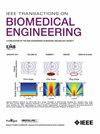Enhanced Technique for Accurate Localization and Life-Sign Detection of Human Subjects Using Beam-Steering Radar Architectures
IF 4.4
2区 医学
Q2 ENGINEERING, BIOMEDICAL
引用次数: 0
Abstract
In this work, we propose a signal processing technique for beam-steering radar architectures allowing concurrent two-dimensional (2-D) localization and vital signs monitoring of human subjects. We demonstrated it by using a single-input single-output (SISO) frequency-modulated continuous wave (FMCW) radar which integrates two frequency-scanning antennas (FSAs). This method is capable of isolating the Doppler signal generated by each single subject from the contributions of all the reflections in the monitored environment. This allows determining the number of individuals in the room and accurately measuring their vital signs parameters (respiration and heart rates) and 2-D positions (range and azimuth information). The spectral analysis, the data matrix generation and the signal processing technique are detailed and discussed. Experimental results demonstrated the feasibility of the proposed approach, showing the ability in determining the number of subjects present in the room, in accurately measuring and tracking over time their vital signs parameters, and in 2-D localization with errors within the limits of the radar range and angular resolutions. Practical applications arise for healthcare, Hospital 4.0, Internet of Medical Things (IoMT), ambient assisted living, smart buildings and through-wall sensing.利用波束转向雷达架构对人体进行精确定位和生命迹象探测的增强型技术
在这项工作中,我们提出了一种波束导向雷达架构的信号处理技术,允许并发二维(2-D)定位和人类受试者的生命体征监测。我们通过使用集成了两个频率扫描天线(FSAs)的单输入单输出(SISO)调频连续波(FMCW)雷达来证明它。该方法能够从被监测环境中所有反射的贡献中分离出每个单独主体产生的多普勒信号。这可以确定房间里的人数,并准确测量他们的生命体征参数(呼吸和心率)和二维位置(范围和方位信息)。详细讨论了频谱分析、数据矩阵生成和信号处理技术。实验结果证明了该方法的可行性,能够确定房间内受试者的数量,准确测量和跟踪他们的生命体征参数,并在雷达距离和角度分辨率范围内的误差范围内进行二维定位。实际应用出现在医疗保健、医院4.0、医疗物联网(IoMT)、环境辅助生活、智能建筑和穿墙传感等领域。
本文章由计算机程序翻译,如有差异,请以英文原文为准。
求助全文
约1分钟内获得全文
求助全文
来源期刊

IEEE Transactions on Biomedical Engineering
工程技术-工程:生物医学
CiteScore
9.40
自引率
4.30%
发文量
880
审稿时长
2.5 months
期刊介绍:
IEEE Transactions on Biomedical Engineering contains basic and applied papers dealing with biomedical engineering. Papers range from engineering development in methods and techniques with biomedical applications to experimental and clinical investigations with engineering contributions.
 求助内容:
求助内容: 应助结果提醒方式:
应助结果提醒方式:


